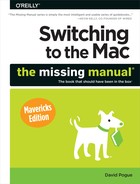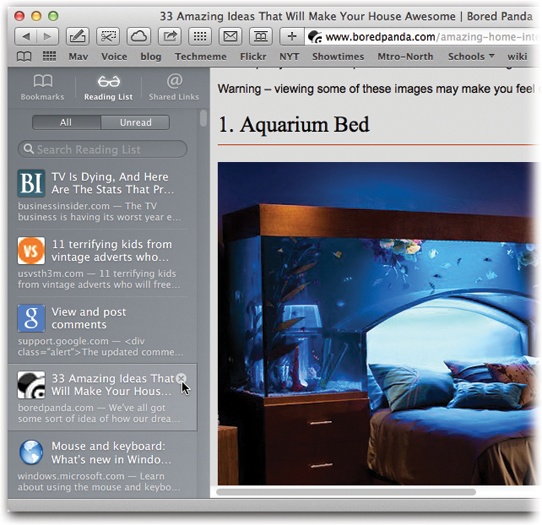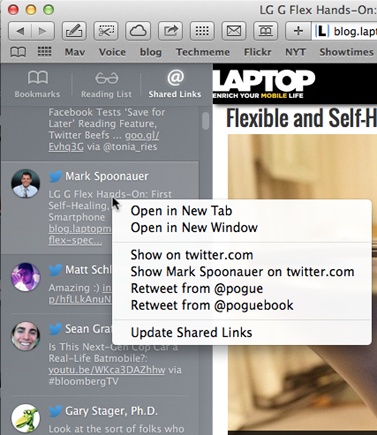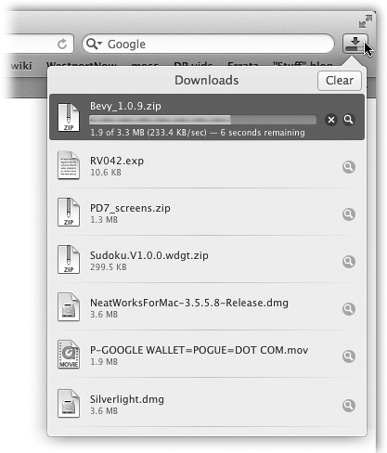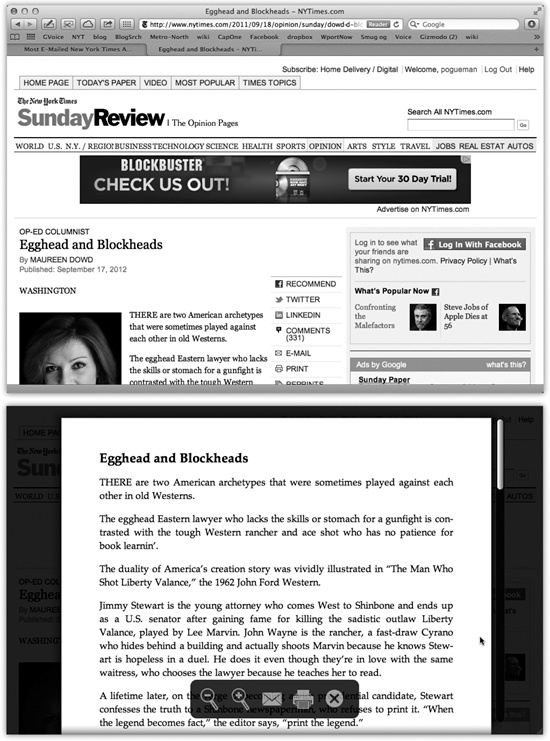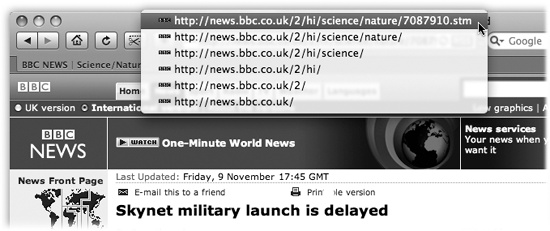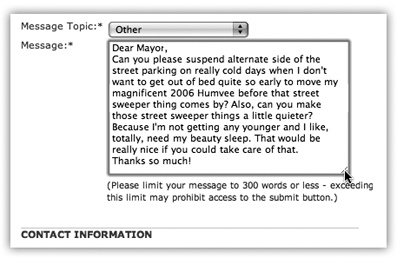Safari is filled with shortcuts and tricks for better speed and more pleasant surfing. For example:
The Reading List lives on the Sidebar, too, alongside your bookmarks. It stores entire Web pages that you want to read later (Figure 12-12). These aren’t just bookmarks (links); the Reading List downloads and stores the full contents of each page you’ve requested so that you can read them when you don’t have an Internet connection. Better than that, actually: It stores that page and any other pages necessary to continue reading an article that you’ve flagged.
That’s not the Reading List’s only advantage over bookmarks. The Reading List also makes it faster to flag a Web page you like—you don’t have to make up a name or a location for it, as with a bookmark. Also, the Reading List keeps track of what you’ve read; you can use the All/Unread buttons at the top of the list to view everything or just what you haven’t yet read.
Figure 12-12. To revisit a page you’ve set aside in the Reading List, just click it. Screen out the pages you’ve already read by clicking the Unread tab at the top. Delete an entry by clicking the ![]() button that appears at the right side when you point there, as shown here by the cursor.
button that appears at the right side when you point there, as shown here by the cursor.
You might treat the Reading List as a list of pages you’ll want to read once later, and use bookmarks for pages you like to revisit frequently.
To make matters even sweeter, iCloud synchronizes your Reading List among your Mac, iPhone, iPad, and so on—as long as you’ve turned on Safari syncing in System Preferences→iCloud. It’s as though the Web always keeps your place as you move from gadget to gadget.
To add a page to the Reading List, use one of these techniques:
Shift-click a link. That simple trick adds the linked page to the Reading List. You don’t have to visit the page itself (only the link to it), or even to open the Reading List itself.
Use the
 button. If you’re already on the page you might want to read later, click the
button. If you’re already on the page you might want to read later, click the  button next to the address/search bar.
button next to the address/search bar.Use the menu. Choose Bookmarks→Add to Reading List, or press Shift-⌘-D.
Use the Share button. You can also click the
 button on the toolbar and choose Add to Reading List.
button on the toolbar and choose Add to Reading List.
To view your saved pages, click the ![]() button on the toolbar to open the Sidebar; then click the Reading List (
button on the toolbar to open the Sidebar; then click the Reading List (![]() ) tab. Or just choose View→Show Reading List Sidebar (Control-⌘-2).
) tab. Or just choose View→Show Reading List Sidebar (Control-⌘-2).
To read the pages in the Reading List, you can press Option-⌘-![]() or Option-⌘-
or Option-⌘-![]() to move up and down your list.
to move up and down your list.
No browser has ever made tracking downloads simpler.
When you click a link to download something from a Web page, it visibly flies to the upper-right corner of the Safari window, where the Downloads button ![]() appears. You can then monitor the progress of the download at a glance—because the Downloads button fills up with blue as the download completes.
appears. You can then monitor the progress of the download at a glance—because the Downloads button fills up with blue as the download completes.
As Figure 12-13 shows, you can also view and manipulate a list of everything you’ve downloaded recently, all without leaving the comfort of whatever page you’re on.
Figure 12-13. Click the Downloads (![]() ) button to view this list of recent downloads. Double-click an icon to open the download. Drag it out of the list onto your desktop, or even onto a folder on the desktop. You can even drag it onto a Dock icon to open that file with a particular program. Click the
) button to view this list of recent downloads. Double-click an icon to open the download. Drag it out of the list onto your desktop, or even onto a folder on the desktop. You can even drag it onto a Dock icon to open that file with a particular program. Click the ![]() button to jump to the file wherever it’s sitting in the Finder. To remove an item from the list, click it and then press Delete. (The Clear button erases the whole list.)
button to jump to the file wherever it’s sitting in the Finder. To remove an item from the list, click it and then press Delete. (The Clear button erases the whole list.)
To pause downloading, click the ![]() button next to the download’s name. Later, you can generally pick up from where you left off by clicking the Resume (
button next to the download’s name. Later, you can generally pick up from where you left off by clicking the Resume (![]() ) button.
) button.
How can people read Web articles when there’s Times-Square blinking going on all around them? Fortunately, you’ll never have to put up with that again.
The Reader button in the address/search bar is amazing. With one click (or press of Shift-⌘-R), it eliminates everything from the Web page you’re reading except the text and photos. No ads, blinking, links, banners, promos, or anything else.
The text is also changed to a clean, clear font and size, and the background is made plain white. Basically, it makes any Web page look like a printed book page or a Kindle page, and it’s glorious (Figure 12-14).
Figure 12-14. Seriously, which way would you rather read an article? Like this (top)? Or in the calm peace of this (bottom)? Not only does Reader get rid of all the ads and clutter and blinking, it even knits multipage articles together into one seamless, scrolling page. Use the space bar or two fingers to scroll, as usual. Point near the bottom of the page to produce a palette of useful buttons: “Zoom out,” “Zoom in,” “Mail this page,” “Print this page,” and “Hide Reader.”
To exit Reader, press the same keyboard shortcut, or click the Reader button again.
Best. Feature. Ever.
The status bar at the bottom of the window tells you what Safari is doing (such as “Opening page…” or “Done”). When you point to a link without clicking, the status bar also tells you which URL will open if you click it.
For those two reasons, it’s a very useful strip, but it doesn’t appear when you first run Safari. You have to summon it by choosing View→Show Status Bar.
Occasionally, you may wish you could view a map that marks the path of the current Web page within its site. Ah, but Safari has already thought of that. See Figure 12-15.
Efficiency freaks generally prefer keyboard shortcuts to using the mouse, so Safari is filled with them.
Press Tab to jump from one text box or pop-up menu to the next on your Web page. Add the Option key to jump from one link to another (and when you highlight a link, press Return to “click” it).
When you see a picture you’d like to keep, right-click (or two-finger click) it and choose Save Image to Downloads (or Add Image to iPhoto Library, or just Save Image As) from the shortcut menu. Safari stores it as a new graphics file, freed from its birthplace on the Web. (You can specify where Safari saves downloaded pictures on the Safari→Preferences→General tab. In that case, the shortcut menu’s wording changes to say, for example, “Save Image to ‘Pictures.’”)
You don’t have to be connected to the Net to read a favorite Web page; you can tuck it away for later, thanks to the newly improved Reading List feature described earlier in this chapter.
The old way of saving a page, though, is still around. You can save it to your hard drive—to archive it for good, or to send it to somebody, for example—by choosing File→Save As.
At that point, to save the entire page, along with all its images, movies, and so on, choose Web Archive from the Format pop-up menu. (Choose Page Source only if you intend to edit the raw HTML Web documents and then repost them, or if you just want to study the underlying code.)
Tip
When you buy something online, don’t waste paper by printing out the “This is your receipt” page. Instead, choose File→Print and, from the PDF pop-up button, choose Save PDF to Web Receipts Folder. Safari saves the page as a PDF file into a tidy folder (in your Home→Documents folder) called Web Receipts. Nice touch!
Safari provides two ways of telling a friend about the page you’re looking at. You might find that useful when you come across a particularly interesting news story, op-ed piece, or burrito recipe.
The send-the-whole-page method. While looking at a page, click the
 button and choose Email This Page. You open a new Mail message with a copy of the actual Web page in the body. Address the message and click Send.
button and choose Email This Page. You open a new Mail message with a copy of the actual Web page in the body. Address the message and click Send.The send-a-link method. To send just a link to the page you’re looking at, install the Mail button (
 ) onto the toolbar, as described on Customizing the Toolbar. When you click it, Safari prepares an outgoing mail message containing only the link to the page you’re on. Then proceed as usual, addressing the message and clicking Send.
) onto the toolbar, as described on Customizing the Toolbar. When you click it, Safari prepares an outgoing mail message containing only the link to the page you’re on. Then proceed as usual, addressing the message and clicking Send.Links take only a split second for your recipient to download, and they’re guaranteed to display properly in all email programs. All your recipients have to do is click the link to open it in their Web browsers.
If the customer-service comment form on that corporate Web site doesn’t give you enough room to rant properly, you can resize the text box right on the page—a very welcome feature. Figure 12-16 tells all.
What’s the first thing you see when you open Safari? Is it the Apple news Web site? Is it the Top Sites display (Figure 12-3)?
Actually, that’s up to you.
Choose Safari→Preferences→General tab. Here the “New windows open with” pop-up menu offers choices like these:
Top Sites. The thumbnail view of your favorites sites makes a great starting point.
Home Page. If you choose this option, then Safari will open up with whatever page you’ve specified in the “Home page” box. Google—or its news page, http://news.google.com—is a good starting place. So is your favorite newspaper home page, or maybe www.dilbert.com for today’s Dilbert cartoon.
If you’re already on the page you like, just click Set to Current Page.
Figure 12-16. This trick works on a Web page’s text fields—comment boxes, forms to send a letter to the mayor, and so on. You can resize such boxes by dragging the three diagonal ribbed lines in the lower-right corner of the text field. The rest of the page adjusts itself to the new text-box size, and you have room to say what you need to say.
Empty Page. Some people prefer this setup, which makes Safari load very quickly when you first open it. Once this empty window opens, then you can tell the browser where you want to go today.
Same Page opens a new window that’s a duplicate of whatever window you just had open.
Tabs for Favorites Bar. This intriguing option creates a row of tabs in a single window—one for every icon on your Favorites bar. The idea, of course, is to have not just one favorite Web page waiting for you in the morning, but all the ones you visit frequently, preloaded and ready to go.
Choose tabs folder. This option is similar to Tabs for Favorites Bar, except that it starts you off with tabs for any random bunch of Web sites—not just the ones on your Bookmarks bar. The trick is to build a folder full of bookmarks and then choose that as the basis for your auto-opening tabs.
The address/search bar can help you find Web sites that match your keywords. But some pages are so long, dense, or poorly designed that finding the words on the page needs a whole ’nother search engine. Fortunately, Safari’s search-within-the-page function shines a light on the word or phrase you’re seeking.
To use it, press ⌘-F and then type your search word into the Find box (Figure 12-17). As Safari locates the word or words, it displays them within a bright yellow box and dims the background of the rest of the page. The Find bar also tells you how many times the word or phrase occurs on the page; you can jump to each instance. Click the ![]() to start over with new search terms, or click Done to close the Find box and return to your normal browsing activity.
to start over with new search terms, or click Done to close the Find box and return to your normal browsing activity.
PDF files are all over the Web as, among other things, forms to download, online brochures, and scanned book pages. But they aren’t always especially readable in a browser window.
Unless, that is, you’re using Safari. The next time you’re squinting at a PDF in a window, point to the bottom edge of the document; you’ll see a toolbar like the one in Figure 12-18 appear. With these four icons, you can zoom out, zoom in, open the file in Preview, or save the PDF file to your Downloads folder.
The History menu lists the Web sites you’ve visited in the past week or so, neatly organized into subfolders like Earlier Today and Yesterday. (A similar menu appears when you click and hold the ![]() or
or ![]() button.) These are great features if you can’t recall the URL for a Web site you remember having visited recently.
button.) These are great features if you can’t recall the URL for a Web site you remember having visited recently.
Tip
See Safari’s Help menu? It features a search box that lets you search all the menu commands in Safari—including Safari’s History menu. That’s just a crazy powerful feature. It means you can re-find a site without having to hunt through all the History submenus manually; just search for a word you remember in the title.
